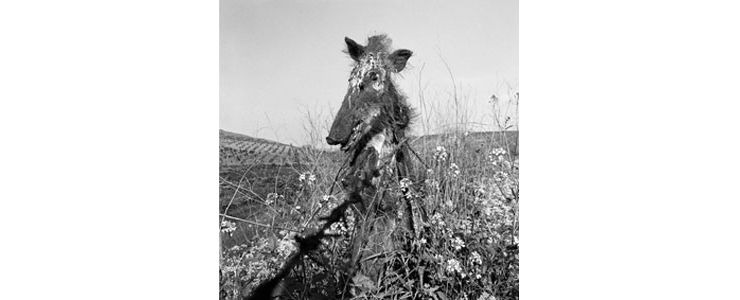In 1995, the photographs of the kibbutz garbage damp in the wadi were presented at the Kibbutz Gallery in Tel Aviv. The current exhibition features an assemblage of wild boar heads mounted on iron spears, which are presented together for the first time. The boars, which were hunted by kibbutz members, were eaten at lavish feasts, while their heads were mounted on the iron spears like crucifixes on a series of crosses. Constituting a pagan spectacle of aggressive power, violence, and masculinity, these images serve as a portrait of contemporary Israeli society and culture. Employing a strategy similar to the one employed in William Golding’s allegorical novel Lord of the Flies (1954), these photographs subvert kibbutz society and Israeli society’s self-perception as cultivated, enlightened, and progressive.
Raz’s photographs raise questions concerning ecological destruction, indifference to aesthetic values, and emotional corruption. These issues appear even more poignant given the special sensibility towards nature that characterized the culture of the country’s agricultural settlements and kibbutzim, where modest nature museums proliferated – including the Man and the Living World Museum in Petach Tikva, the Nature Museum in the National Park in Ramat Gan, the Beit Shturman Museum on Kibbutz Ein Harod Meuchard, Beit Usishkin on Kibbutz Dan, and Beit Gordon on Deganya. These numerous museums (named after important members of the country’s founding generations) attest to the special attitude towards the preservation of nature and of the natural world, and to its collection for educational purposes, during the first years of Israeli statehood. What of all this was internalized by the wild boar hunters, who were raised in accordance with this pedagogical and ideological worldview? According to the artist, the aggressive culture characteristic of former Israeli soldiers, and of combat fighters more specifically, has infiltrated Israeli society at large, as sadly evidenced by these photographs.
The garbage dump in Wadi Sidr, where the cadavers of the hunted animals were disposed of, has since been closed down, while the disturbing presence of these photographs continues to confront their viewers.
Less Reading...
